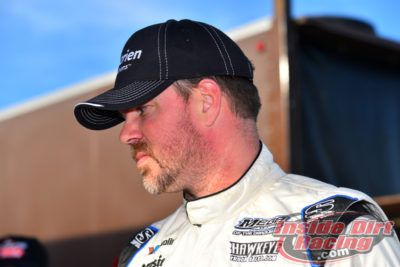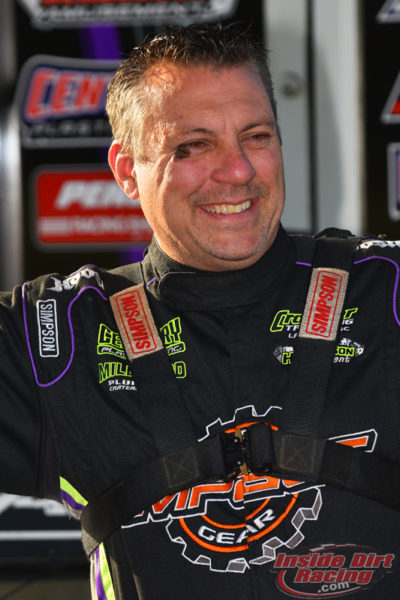The latest edition of the Turn 2 Blog is presented by the American Crate All-Star Series.
*Turn 2 Blog is a regular feature on InsideDirtRacing.com. Here, site operators Michael Moats and Richard Allen take turns offering their thoughts on the dirt racing topics of the day from east Tennessee and beyond.
Richard: As we have pointed out on here before, we are right in the middle of the crown jewel season for Dirt Late Model racing. And another big event has come and gone as the $50,000-to-win USA Nationals at Cedar Lake Speedway in Wisconsin was contested this past weekend. As it turned out, two major stories emerged from that race.
Let’s start with something that happened before Saturday night’s feature even took the green flag.
Jonathan Davenport left Cedar Lake early after suffering significant damage to his car during the preliminary races. The current Lucas Oil Late Model Dirt Series points leader and his team decided against pulling out their backup car to race in the B-mains and instead headed back to their shop. With Lucas Oil races coming up this week at Florence Speedway they did not want to run the risk of damaging a second car with two points-paying features and a major purse on the line in Kentucky.
But the No. 49 crew’s choice to leave was not the only major issue. During the long ride home, Davenport took to Twitter to express his displeasure with the way the starting lineups are set for some of the sport’s biggest races. In particular, the @TheFast49 posted that he is opposed to the use of the “passing points” system used for the USA Nationals, the Silver Dollar Nationals, and the North-South 100 among others.
Davenport’s full comments can be read here –> Jonathan Davenport speaks out against passing points; Lack of team input in formats
A passing points system takes away time-trials and instead calls for drivers to draw for starting positions in two sets of heat races. The heat race lineups are inverted from the first and second rounds based on the draw. At the completion of the heats, the drivers who have accumulated the most points depending on how many positions they gained or lost will be given a place on the starting grid.
Some drivers, including Davenport, have concerns regarding the randomness of the draw and the additional heat racing required by the format. A major fear is that the additional racing combined with the random draw sets the stage for disaster such as Davenport experienced at Cedar Lake.
With all that explanation done, I will state here that I am not much of a fan of time-trials. In my opinion, they tend to be long and even a bit boring. At the same time, I can see the racer’s point in that random draws are just that- random. After spending countless hours in a shop preparing a car, I would not want luck of the draw to determine my fate.
My issue with the passing points system is that it requires too much calculation for the average person watching from the grandstands to keep up with. From my point of view, you watch a lot of racing(which is great) but you then have to wait for the points to be added and subtracted by series officials before the starting lineup is set.
It’s a tough call because fans don’t want to see the best cars just out qualify everyone else then win a heat race and go on to win the feature from the pole while teams don’t want to risk all of their hard work on a somewhat random and complicated system.
What is your reaction to what Davenport had to say?
Michael: On one hand, I’m sure lots of frustration was on Davenport’s mind when he took to Twitter to vent. On the other hand, passing point heat races are much more common in the northern states and fans there come to expect the same format for any race they see. We are seeing these more and more in the big paying races. Fans won’t come out to watch one set of heat races on the first night. To boost attendance, promoters and series directors have come up with other ways to get the fans to come out for multiple nights.
I don’t mind the idea of mixing things up in hopes of providing more competitive racing for the fans. As I have stated in the past, heat races with passing points are a bit confusing from the standpoint that a fan doesn’t know what the results really mean until the night is complete and the math is done. I prefer something where I know who is where in regards to the main event and consolation races once each heat is done. Maybe inverting the top-4 for each heat would be a good alternative for the fans and drivers based on time trials. Otherwise, more tracks may have to go to 3 nights of racing where the average results from nights 1 and 2 determine heat lineups for the heat for the main event. But promoters would be taking a huge risk running 3 nights.
Richard: I’m always in favor of having more racing and less qualifying during an event. But as you say, there’s something just not right about having to wait until everything is over before finding out who is starting where.
The three-night format in which the track runs two sets of features on the first two nights of the weekend are no doubt what the teams would prefer because they would be getting paid each night. But you made a good point in that it would be a tremendous risk for the promoter to stage such an event. Only tracks such as Eldora or Knoxville can be assured of success going into that type of weekend.
*Note: In a poll conducted on my @RichardAllenIDR Twitter account, the following question was posed:
Jonathan Davenport made it clear how he feels regarding the setting of starting grids for major Dirt Late Model races. What format do you prefer?
— Richard Allen/InsideDirtRacing.com (@RichardAllenIDR) August 5, 2019
Another point raised by Davenport was that of the teams not having a say in formats. I am going to have to disagree with the star driver on this one and say that as long as the format is something reasonable, the teams need to race the program that is in place.
After listening to a recent “Dale Jr. Download” podcast with Dale Earnhardt, Jr. and Chase Elliott in which both drivers stated that they did not like the idea of driver counsels and meetings with officials, I believe that the leaders of the sport need to be in charge. NASCAR has shown over the last couple of decades that too many cooks can most definitely spoil the broth. If tracks and/or series start trying to hold meetings to discuss what formats ought to be used there will be nothing but confusion and frustration to come from that.
That’s not to say that the tracks or series should never listen to drivers and team owners but they do need to lead first and take in other opinions only after careful consideration. Again, as long as the formats are reasonable(and I know that’s a relative term), the leaders of the sport need to lead and the participants need to participate or stay home based on the rules set in place.
Your thoughts?
Michael: It’s been my opinion the drivers should never be the ones to set the rules. Should they have input? Yes. But they should not be the sole determiners when it comes to things like this. We already have enough racetracks and series that are run by current or former drivers that have their formats leaned heavily toward what the drivers want.
My thought is starting spots for any Late Model class should not be determined by the luck of the draw. That’s not to take away from other classes. But your headlining class should not be left up to chance, especially with a lot of money involved. It leads to lack of trust that the process is being run fairly. Besides, I harp enough on lack of racing at weekly programs, I do encourage heat races for other classes. Which goes back to my first point of drivers not being allowed to dictate the program.
Richard: Staying on the subject of the USA Nationals but now focusing on the track, the second big story from that race revolved around the big night for Chris Madden. After what has been a crazy year for the Gray Court, SC driver, he pocketed $50,000 for the win while essentially driving a second car for Scott Bloomquist Racing.
Madden began the season in a Capital Race Car owned by Greg Bruening but things came apart there and, for a short time, the talented ace was without a ride. But after a reunification of sorts with Bloomquist where he even acted as a crew chief for the Zero car, Madden was back behind the wheel at Cedar Lake and showed that even during this up and down campaign he is going through he is still one of the top drivers in the business.
Some fans very much like Madden and others may not but the sport is always better off to have as many stars as possible doing well, isn’t it?
Michael: I think the World of Outlaws is missing Madden this year. Brandon Sheppard has dominated this season and with Mike Marlar not returning to the tour this year, it would have been up to Madden to challenge for some of those wins.
Madden is one of the nicest guys off the track, but he’s a different person behind the wheel. That’s one of the things that stokes the fires of the fans that like him or dislike him. He should be a positive influence for Bloomquist on and off the track.
With so many of the big money races remaining that are sanctioned by the Lucas Oil Late Model Dirt Series, Madden should be running in many of those races. Adding Madden to the mix of Davenport, McCreadie, Owens, Richards, and Erb should make for some interesting races over the last few months of the season.
Richard: It’s really pretty amazing to think that of all the races and championships Madden has won that the USA Nationals was his first crown jewel victory.
I agree with you that Madden has been missed on the WoO Late Models schedule this year but I’m not sure anyone could derail Sheppard and his team as good as they are right now. And yes, adding “Smokey” to the mix should spice up the remaining big money races even more than they already would have been.
Respond to this post on Twitter by following @RichardAllenIDR and @MichaelRMoats or by liking the InsideDirtRacing.com Facebook page.
Also, NASCAR and pavement racing fans can check out InsideCircleTrack.








